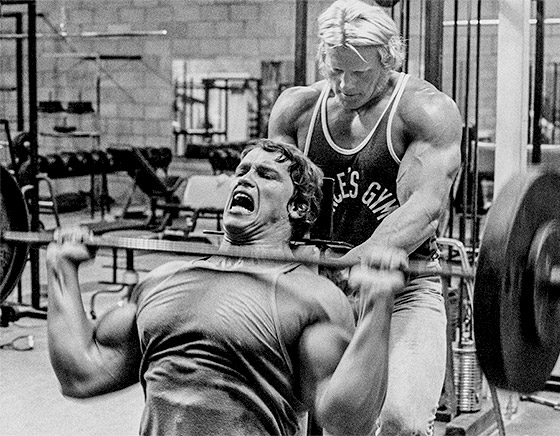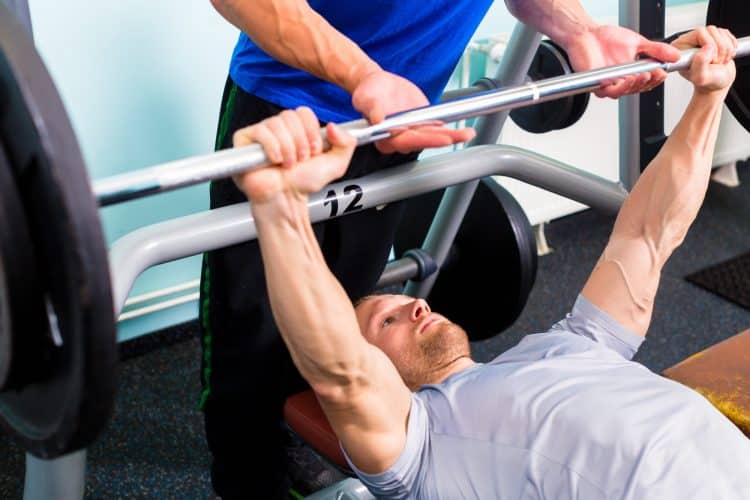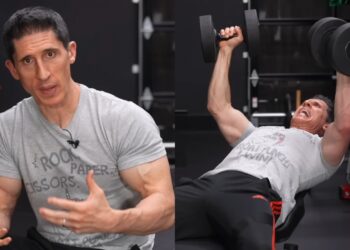Take your sets beyond failure to build more size and strength.
It’s often said (by me, at least!) that easy workouts don’t build muscle and strength. By nature, your body is incredibly lazy and would prefer not to waste energy on making you bigger and stronger. Therefore, it needs a compelling reason to spend its resources on muscle growth.
That’s why most training information recommends that you take your sets close to failure. It’s only by exposing your muscles to such a high degree of tension and fatigue that you trigger the cascade of reactions responsible for hypertrophy.
This is called the effective reps theory, which suggests the final part of each set is the most productive, and the reps leading up to that point are merely unavoidable stepping stones.
Of course, once fatigue sets in, your set inevitably comes to a halt. As such, the productivity of each set has limits. But what if you could go beyond failure? Would that make your workouts more productive?
One way to achieve this seemingly impossible task is with forced reps. This training method involves using a partner to help you push out a few more reps, taking your set beyond its usual termination point. Theoretically, this means more effective reps and better muscle size and strength gains.
Level Up Your Fitness: Join our 💪 strong community in Fitness Volt Newsletter. Get daily inspiration, expert-backed workouts, nutrition tips, the latest in strength sports, and the support you need to reach your goals. Subscribe for free!
In this guide, we reveal why, how, and when to use forced reps and the alternative methods you can use instead.
What Are Forced Reps?
Watch almost any thriller, military, spy, or courtroom movie or TV show, and you’ll invariably hear the words, “Failure is not an option.” This tired old trope suggests that failing is a bad thing and it’s best avoided.
While that may hold true in life-or-death scenarios, it’s a different story in the gym.
In fact, not only is failure an option during strength training, it may also be desirable. After all, getting close or hitting failure is what drives many of the adaptations that make your muscles bigger and stronger. It’s the spark that ignites your gains.
That’s not to say you HAVE to reach failure to build muscle and strength. However, the further you stop your set from failure, the less productive it will be. Subsequently, going beyond failure may theoretically lead to better growth and strength gains.
One way to exceed failure in strength training is by using forced reps. But what are forced reps, and who uses them? Let’s take a look!
Forced reps, also known as assisted reps, are a technique that bodybuilders use to ramp up workout intensity. A spotter assists the lifter to complete extra reps when they can’t muster the strength or energy to continue on their own.
The spotter provides just enough assistance to allow the lifter to overcome the sticking point of the exercise and complete the repetition, thereby extending the set beyond its usual termination point. Usually, 1 to 4 forced reps are done at the end of a regular set.
This technique creates significant fatigue and muscle tension, both of which are prerequisites for muscle growth and strength gains.
It’s important to note that studies suggest forced reps might not offer a significant advantage over training to failure when it comes to muscle growth (1).
However, bodybuilders have been using this technique for decades, which suggests it does have some merit. After all, if forced reps didn’t work, they’d have gone the way of the dinosaurs, and they’d have fallen out of favor. However, any advantages offered are minimal.
Moving on, in the next section, we reveal how to do forced reps, both with a spotter and when training alone.
How to Safely Perform Forced Reps
Forced reps can be risky as they push your muscles several reps beyond failure. As such, you will invariably reach a point where you could become trapped under a heavy bar, e.g., during bench presses or squats.
Because of this, you must learn how to use this training method correctly. After all, you will lose any potential gains if you need weeks or months off training because of an otherwise avoidable injury.
Safety first, folks! Follow these guidelines to maximize the benefits of forced reps while minimizing risks.
Forced Reps with A Spotter
Forced reps are typically done using a spotter. Ideally, this should be someone experienced with forced reps and who knows how to effectively safeguard the person they’re working with.
However, the spotter must also understand that their job is to provide as little help as necessary, as giving too much help will negate the benefit of doing forced reps. This is a fine balance that can take time to learn. With forced reps, practice makes perfect.
- Warm up to ensure your muscles and joints are ready for the challenges of your workout. Select the required amount of weight.
- Tell your spotter how many reps you plan on doing alone and how many forced reps you want to perform. Agree on what signals you’ll use if you need to change your plan mid-set.
- Start your set and rep out as usual. Use good form throughout. Continue until you are unable to complete further reps unaided. Your spotter should remain nearby, closely monitoring the progress of your set and ready to step in when needed.
- As you reach failure, your spotter should then help you past the sticking point of the exercise being performed, assisting just enough to keep you going. They should only need to help you lift, and you should lower the weight under your own muscle power.
- Continue for the desired number of forced reps, typically 1-4. The spotter may need to increase their assistance as you become more fatigued.
- On completion of your set, the spotter should help you rerack or put the weights down. Keep in mind you’ll be very tired and may struggle to control the weights alone.
Forced Reps When Training Alone
You can be your own spotter when you do unilateral or single-limb exercises. For example, you can lift and lower the weight with one arm and then, as you hit failure, use your other arm for assistance. This works well with exercises like concentration curls, single-arm triceps pushdowns, and leg extensions/leg curls.
Here’s how to do forced reps with leg presses:
- Warm up to ensure your muscles and joints are ready for the challenges of your workout.
- Select the required amount of weight.
- Using one leg, lift and lower the weight until you cannot complete any more reps unaided. Use good form throughout.
- On reaching failure, use your non-working leg for assistance and crank out another 1-4 reps. Avoid doing more work than necessary with your assisting leg – provide the least amount of help needed to complete the extra reps.
- Rest a moment, switch sides, and repeat.
Now that you know how to perform forced reps, with and without a spotter, let’s look at the best times to use them.
When to Use Forced Reps
Forced reps are one of the many tools available to build muscle and strength. And, like hammers and screwdrivers, there is a right time to use each one. After all, you wouldn’t try and drive in a nail with a wrench, would you?
These are the best times to include forced reps in your strength training and bodybuilding workouts:
Busting Through Plateaus
Even the best bodybuilders suffer from progress plateaus from time to time. They can happen for several reasons, including sticking with the same program for too long, losing motivation, or taking it too easy in the gym.
Forced reps expose your muscles to a novel stimulus, which may be enough to dig you out of your current training rut. Think of forced reps as the hammer that smashes through plateaus. However, resist the temptation to wield this hammer too often, as it may be too intense for frequent use.
At the End of a Training Block
If you usually use a periodized approach to your workouts, you already know how each training block builds on the last, progressing toward an intensity and volume peak. Using forced reps is a great way to conclude a training phase, as going beyond failure is about as intense as you can get.
Remember to deload for a week at the end of your training block before building things up again to a new, higher peak.
Before a Planned Layoff
Going on vacation or a business trip? We hope it goes well! However, before taking time off training, consider adding forced reps to your workout and pushing your training to a new level of intensity. That way, during your time away from the gym, your body can supercompensate and bounce back bigger and stronger.
This is called overreaching and is a valuable way to take your strength and muscle mass to a whole new level.
During A Bulk
Bulking involves eating more than usual – much more. This surplus of calories should help you gain weight and muscle mass more quickly. You’ll get a better result from your bulk if you increase your training volume alongside your calorie intake, and forced reps are one way to do this. After all, you might as well put those extra calories to good use, right?
To Reach New Performance Levels
Imagine the scenario: you’re training to do ten reps of bench press with 100kg/225 pounds. But, try as you might, you can’t get past seven reps. Talk about frustrating. One way to crush your goal is with forced reps. Use a spotter to help you reach your ten-rep goal with 2-3 forced reps. Gradually reduce the spotter’s assistance until you can complete all ten reps on your own.
You’ve Got More Energy Than Usual
We’ve all had workouts where, for reasons too various to mention, we feel stronger or more energetic than usual. Make the most of your temporary energy glut by adding some forced reps to the end of your sets. This will ensure you leave no unused energy in the gym and can walk away feeling like you gave every set your best effort.
Armed with this information, you now know the best times to employ forced reps in your workouts. Keep reading to discover the benefits of forced rep training.
The Benefits and Drawbacks of Forced Reps
Now you know how and when to use forced reps, the question is, are you going to include them in your next workout? Before you make up your mind, consider these pros and cons.
Benefits of Forced Reps
Break Training Plateaus: We’ve already discussed how using forced reps can help you overcome training plateaus, but it’s such a powerful reason that it’s worth reiterating. If your progress has ground to a halt, a few workouts of forced reps should get things moving again. Like a heavy sledgehammer, you can use forced reps to smash through your barriers and restore progress.
Maximize Muscle Activation: Your muscles are made of bundles of bundles of individual fibers. If you want to maximize growth, it pays to engage as many of these muscle fibers as possible. Forced reps extend your set beyond failure so you can tap into and stimulate any as-yet unused motor units and muscle fibers, providing a greater stimulus for growth.
Enhance Workout Intensity: Intensity means two different things. On the one hand, it’s the amount of weight you’re lifting relative to your one repetition maximum or 1RM for short. On the other, it’s how much mental and physical effort you’ve got to use to complete a given set.
Forced reps allow you to use more weight and do more reps, which will take more effort, dialing up both intensity measures. More intensity usually leads to more productive workouts.
Accelerate Strength Gains: More challenging workouts mean faster strength gains. If you want to get stronger, forced reps can help. This is especially true when you’re training with heavy loads and lower reps, e.g., 3-5 per set.
More Efficient Workouts: You can train hard, or you can train long, but you can’t do both. Using forced reps allows you to wring every last benefit out of your workout without resorting to doing lots of sets. 1-2 sets of forced reps will have a similar effect to 3-4 straight sets taken to failure.
Improve Muscle Endurance: Training past failure will flood your muscles with lactate. While it’s temporarily debilitating, regular exposure to that burning sensation will improve your lactate tolerance, making you less susceptible to its effect. This ability to push on despite fatigue is called muscular endurance. Needless to say, this is a very valuable fitness component in sports and bodybuilding.
Boost Mental Toughness: Pushing a set beyond failure won’t just build muscle and strength; it’ll also toughen your mind. You know that going beyond failure will hurt, but you’re going to do it anyway. Just imagine how much easier straight sets will feel in comparison.
Drawbacks of Forced Reps
Increased Risk of Injury: There is a small risk of injury with any type of strength training; however, forced reps increase that risk even more. Forced reps expose your muscles and joints to increased tension and stress, and there is a danger of accidents should your spotter fail in their duties. As such, you should always consider the benefits AND drawbacks of forced reps before adding them to your workouts.
Potential for Overtraining: The harder you train, the more you take out of your muscles and nervous system. Without adequate recovery, rest, sleep, and food, you could find that your workouts take more out of you than you can put back in. If forced reps leave you feeling exhausted for days at a time, they may be too intense for your current level of conditioning.
Requires a Skilled Spotter: While you can do forced reps alone, e.g., with unilateral exercises like leg extensions and concentration curls, most are done with the aid of a spotter. As well as helping you push past failure, your spotter must also keep you safe and prevent the weight from crashing down on you.
Needless to say, this is an acquired skill, and not everyone knows how to do it. Avoid asking inexperienced spotters to help you do forced reps, as serious accidents can happen if they make a mistake. Trust and good communication are critical for safe forced reps.
May Lead to Imbalanced Development: Forced reps are better for some exercises than others. For example, they work great for bench presses and biceps curls but are less useful for bent-over rows or squats. As such, if you use them too often, forced reps could lead to some muscles becoming more developed than others. Such imbalances will affect not only how you look but also how your body functions.
Not Suitable for All Exercises: While you can theoretically use forced reps with any exercise, some movements work better than others. Exercises like calf raises, cable crossovers and bent-over rows are impractical for forced reps. You’ll need to experiment to determine which exercises are suitable for forced reps and which are not.
Level Up Your Fitness: Join our 💪 strong community in Fitness Volt Newsletter. Get daily inspiration, expert-backed workouts, nutrition tips, the latest in strength sports, and the support you need to reach your goals. Subscribe for free!
Limited Application for Solo Trainers: While solo trainers can do some forced rep exercises, most are impractical alone. The good news is that there are several solo-friendly methods you can use instead, such as drop sets and myo-reps, all of which we’ve detailed elsewhere in this guide.
Could Affect Recovery Time: Pushing your muscles past their usual limit could mean you need longer recoveries between sets and workouts. You should also expect your muscles to be more sore than usual, especially the first few times you use this high-intensity training method.
Now you understand the benefits and risks of forced reps, let’s take a look at the most common mistakes people make with this training method and how to avoid them.
Common Forced Rep Mistakes to Avoid
Get more from forced reps by avoiding these common mistakes.
- Overusing Forced Reps: While forced reps can be a powerful tool, they shouldn’t be the only tool in your toolbox. Using them too frequently can lead to overtraining and diminish their effectiveness.
- The Spotter Is Doing Too Much Work: The role of the spotter is to assist, not to lift the weight for you. If the spotter is doing too much, it defeats the purpose of going beyond failure.
- Poor Communication with Spotter: Failing to clearly communicate your rep goals and signals can lead to a less effective and potentially dangerous set.
- Skipping Warm-Up: Forced reps are intense; jumping into them without a proper warm-up is asking for trouble.
- Incorrect Weight Selection: Using too much or too little weight can either make the forced reps ineffective or too risky.
- Ignoring the Need for Perfect Form: In the quest to push past failure, some may compromise on form, which is a recipe for injury. Doing forced reps should not affect your technique.
- Lack of Rest and Recovery: Forced reps demand more from your muscles, so adequate rest and recovery are crucial.
- Ignoring Individual Differences: What works for one person may not work for another. Always listen to your body when incorporating forced reps.
- Inadequate Attention to Nutrition: Forced reps are taxing and require proper fueling before and effective recovery nutrition afterward.
- Not Tracking Progress: Without keeping track of how many forced reps you did and how you felt afterward, it’s hard to gauge their effectiveness or adjust as needed. Record your workouts so you know how you’re progressing and can plan subsequent workouts more effectively.
While forced reps are a great way to expose your muscles to more intensity and stimulus, they’re not the only method available. Check out the following section to learn about some alternative post-failure training methods.
Alternatives to Forced Reps
While we LOVE forced reps and are sure you will, too, they’re not the only way to take your workouts beyond failure. In fact, if you are a solo trainer, forced reps may be impractical.
With that in mind, here are a few additional training methods you can use to push past failure, even if you train alone:
Drop Sets
Just because you can’t do any more reps with a given weight doesn’t mean your muscles are completely fatigued. Instead, it just means you cannot produce enough muscle force to overcome that particular load. If only we could magically make the weight lighter…
With drop sets, the aim of the game is to lower (or drop) the weight as you hit failure so you can crank out a few more reps. This extends your set and, in theory, means doing more effective reps.
For example:
- 10 reps 100 pounds (can’t do 11)
- Reduce the load to 80 pounds
- 6 reps (can’t do 7)
- Reduce the load to 60 pounds
- 4 reps (can’t do 5)
- Reduce the load to 40 pounds
- 5 reps (can’t do 6)
This constitutes a triple drop set, as the weight was lowered three times. You can make anywhere from one to four or more drops depending on how much you want to suffer and the size of the initial load.
Learn more about drop sets here.
Negative Reps
Negative reps are similar to forced reps. However, with this method, on reaching failure, your training partner helps you lift the weight, and you lower it alone. They then help you lift the weight again so you can lower it a couple more times.
This method works because you are stronger eccentrically than you are concentrically. In other words, you can lower more weight than you can lift. Just because you can no longer lift a weight doesn’t mean you still don’t have the strength to control its descent.
However, just like forced reps, this is a very intense, advanced training method that’s best left to experienced exercisers.
Discover the positive power of negative training here.
Myo-Reps
Myo-reps are a form of rest-pause training. This post-failure system takes your muscles to failure and then gives them a short rest, typically 10-20 seconds. After that, you pump out several more low-rep sets to continue working beyond failure. However, unlike drop sets, the weight remains unchanged.
For example:
- 12 reps (to failure)
- Rest 15 seconds
- 4 reps (1st mini set)
- Rest 15 seconds
- 4 reps (2nd mini set)
- Rest 15 seconds
- 4 reps (3rd mini set)
- Rest 15 seconds
- 4 reps (4th mini set)
- Rest 15 seconds
- 4 reps (5th mini set)
Myo-reps mini sets typically involve doing 20-25% of the number of reps performed in the initial “activation” set. You then either do five mini sets or stop when you start dropping reps.
In addition to pushing your muscles beyond failure, myo-reps are also very time efficient, as one run-through per exercise is usually all that’s needed.
Check out our detailed myo-rep guide for more information.
Agonist Supersets
There are many different superset “flavors,” but agonist supersets are one of the most straightforward ways to push your muscles beyond failure. With this method, you simply do two back-to-back exercises for the same muscle group. The change in movement ensures that different, untested muscle fibers get a workout, allowing you to push beyond failure.
For example:
- Wide-grip bench press to failure
- No rest
- Chest press to failure
- Rest for 1-2 minutes and repeat the pairing 2-3 more times
Read more about supersets in this detailed guide.
Pre- and Post-Exhaust Supersets
Where agonist supersets involve doing two similar exercises back-to-back, pre- and post-exhaust training specifies the type and order of the exercises.
Pre-exhaust involves doing an isolation exercise before a compound exercise for the muscle you want to train. For example:
- Leg extension (isolation)
- No rest
- Leg press (compound)
- Rest for 1-2 minutes and repeat the pairing 2-3 more times
In contrast, with post-exhaust, the order is reversed. For example:
- Lat pulldown (compound)
- No rest
- Straight arm pulldown (isolation)
- Rest for 1-2 minutes and repeat the pairing 2-3 more times
Both pre- and post-exhaust training allows you to drive your muscles beyond failure and are ideal for those who prefer to work out alone.
Learn more about pre- and post-exhaust superset training here.
Now we’ve armed you with an arsenal of techniques to push your workouts beyond failure, you might have some burning questions. Don’t sweat it; we’ve got you covered. Let’s dive into some frequently asked questions to clear up any uncertainties you may have.
Forced Rep FAQs
Do you have a question about forced reps? No problem, because we’ve got the answers!
1. Can I do forced reps without a spotter?
While forced reps are typically performed with assistance from a spotter, some forced-rep exercises can be performed alone, e.g., concentration curls, leg extensions, and leg curls. To do solo forced reps, you lift and lower the weight using one leg or arm and then self-spot for a few extra reps using your non-working limb.
2. How many forced reps should I do?
Theoretically, you can do as many forced reps as your training partner can tolerate. After all, the more forced reps you do, the more exhausted you’ll become and the more work they’ll need to do. Continue long enough, and they could end up doing all the work!
So, for practicality and in fairness to your spotter, anywhere from 1-4 forced reps should suffice. Even one forced rep is one more than you’d be able to do alone and should have a positive impact on your progress.
But remember, forced reps take a lot out of your muscles, and the more you do, the more recovery you’ll need between sets AND workouts.
3. Are forced reps suitable for beginners?
If there is a group of exercisers who should not do forced reps, it’s beginners. Beginners should be able to get all the training effects they need from regular or straight sets. In the early stages of their lifting journey, most beginners should find that basic workout methods are still novel and sufficiently stimulating.
If you’ve been lifting for less than a year, you should skip forced reps, as you just don’t need them yet. Save the big guns, like forced reps, drops sets, myo-reps, etc., for when basic training methods start to lose their effectiveness.
4. What exercises work best with forced reps?
When it’s time to incorporate forced reps into your workout routine, the first step is selecting the right exercises. Typically, you can use forced reps for barbell presses, machine exercises, and various arm exercises.
Here’s a short list to consider:
- Barbell bench press
- Barbell curl
- Close-grip bench press
- Dumbbell bench press
- Hack squat machine
- Lat pulldown
- Leg curl machine
- Leg extension machine
- Leg press
- Lever row
- Lying triceps extension (aka skull crushers)
- Machine chest press
- Machine shoulder press
- Seated barbell shoulder press
- Seated dumbbell shoulder press
However, you can experiment with other exercises to determine whether they are also suitable for forced reps.
5. Can forced reps lead to overtraining?
Overtraining occurs when your workouts exceed your ability to recover. Recovery is dependent on sleep, rest, and nutrition. Because forced reps take more out of your body than conventional strength training, there is a danger that you might fail to recover completely between workouts.
While you may be able to shrug this off and power through your next few workouts unaffected, if your training regularly exceeds your ability to recover, overtraining will result.
The symptoms of overtraining include:
- Chronic fatigue
- Decreased performance
- Increased resting heart rate
- Insomnia
- Irritability
- Loss of appetite
- Muscle soreness
- Persistent injuries
- Reduced immunity
- Weight loss
If you experience any of these symptoms, it could be because you are not recovering sufficiently between workouts. Too many forced reps could be the reason. However, you may simply be paying too little attention sleep, your diet, etc.
6. Where is the best place to put forced reps in my workouts?
The ideal place for forced reps is at the tail end of your workout, specifically during the final set of your last few exercises. This strategy ensures you’re pushing your muscles to the limit without sacrificing the quality of your earlier sets. Think of forced reps as your workout’s grand finale.
Alternatively, consider using them after your first main exercise for the muscle group you’re training. After all, this is generally the most important movement in your workout. Note, though, that this may reduce your performance in the latter stages of your workout.
Both options can work, so try each of them to see what’s best for you. However, remember to use and not abuse forced rep. Doing them too often could lead to overtraining and impaired progress.
7. Can women use forced reps?
Forced reps are an equal opportunities training method suitable for men and women. If you are female and want to maximize muscle and strength, then forced reps deserve a place in your workout toolbox. However, suppose you are more interested in general fitness or fat loss. In that case, forced reps are probably unnecessary, and that applies to both men and women.
Forced reps – Closing Thoughts
We have a saying in the fitness industry: If you only do what you’ve always done, you’ll always get what you’ve always got. In other words, if you want to change your body, you need to change your workouts, challenging your muscles with more work so they respond by getting bigger and stronger.
There are lots of methods you can use to keep gaining muscle and strength, including progressive overload, increasing volume, and changing your workouts every couple of months.
Another option is to use training intensifiers, such as drop sets, supersets, negatives, and, the subject of this guide, forced reps.
Forced reps allow you to push your muscles beyond failure, exposing them to more work than usual. This can be helpful for maintaining your progress or blasting through plateaus. However, this is an intense training method that, if overused, can soon lead to overtraining. It’s unsuitable for beginners, too.
So, how do you know if forced reps are right for you? By trying them, of course. Recruit an experienced spotter to help you, or try them on your own with the solo methods outlined in this guide.
Forced reps are tough, but it’s those tough workouts that drive your progress. Give them a try and remember to let us know how you got on in the comments section below!
References:
1 – Hackett, Daniel A. PhD; Amirthalingam, Theban BHSc (Hons). A Brief Review of Forced Repetitions for the Promotion of Muscular Hypertrophy. Strength and Conditioning Journal 37(5):p 14-20, October 2015. | DOI: 10.1519/SSC.0000000000000150














